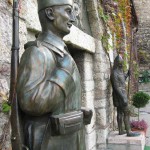Ruzica Church, dedicated to the feast of the birth of the Mother of God, is today a revered sanctuary within the walls of the Belgrade Fortress. It was built in 1867 and was originally supposed to serve as a military temple. For that purpose, the Austrian gunpowder warehouse from the fourth decade of the 18th century was adapted. During the renovation of the building, the bell tower was erected and the altar apse was added. According to popular belief, there was a church of the same name in this place in the Middle Ages, but there is no confirmation of that.
The very name of the church, Ruzica, was taken from the much older pagan holiday of Rosalie, which was celebrated by the participants of the festival being sprinkled with rose petals. As the Orthodox holiday of the Holy Trinity coincided with the ancient Rosalie, many churches that were built in the Serbian lands during the Middle Ages were popularly known as Ruzica.
The church was severely damaged during the First World War in 1915 and was thoroughly renovated in 1925, when it received its current appearance. The renovation design was done by the Russian architect Nikolay Krasnov. Since it was a military sanctuary, part of the interior of Ruzica consists of massive chandeliers made of trophy weapons from the First World War. In front of the entrance to the church, there are two bronze statues, one of which represents a medieval warrior from the time of Emperor Dusan and the other a Serbian soldier from the beginning of the 20th century. These sculptures are cast from cannon shells.
The frescoes in the church were made in 1938 by the Russian painter Andrei Vasilyevich Bitsenko (1886–1985). In addition to the usual religious motifs and biblical scenes, the vault depicts a procession of Serbian rulers, and on the west wall, in the composition Sermon on the Mount of Olives, some contemporary personalities are represented, such as Russian Tsar Nicholas II, Kings Petar and Aleksandar Karadjordjevic and others.







